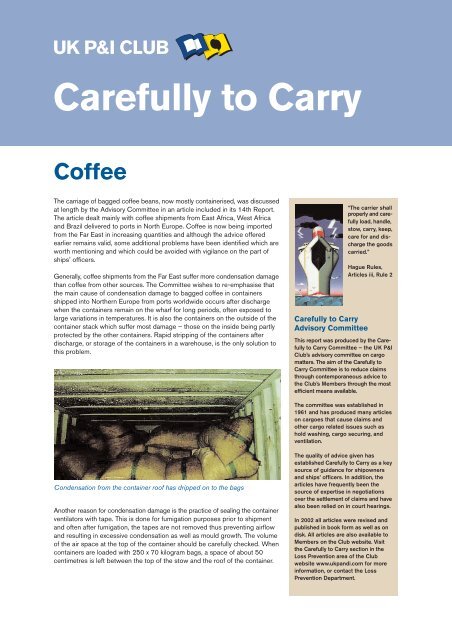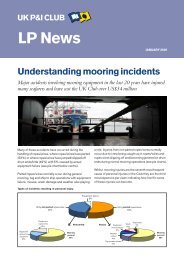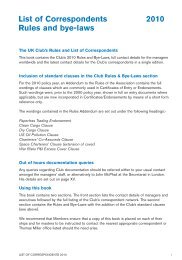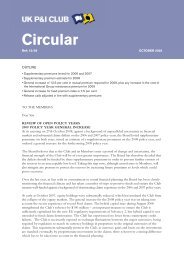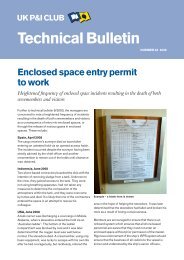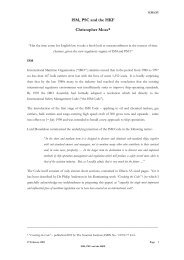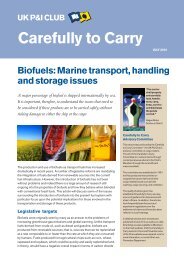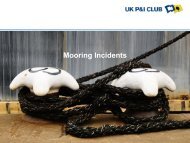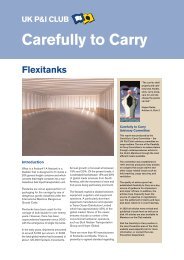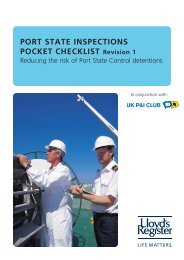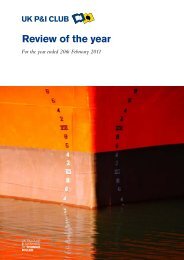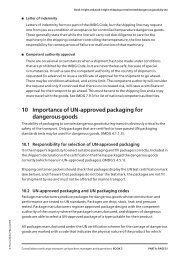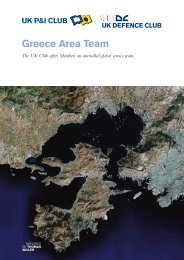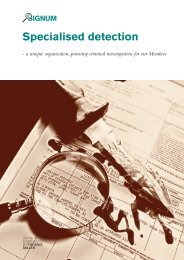Coffee - UK P&I
Coffee - UK P&I
Coffee - UK P&I
You also want an ePaper? Increase the reach of your titles
YUMPU automatically turns print PDFs into web optimized ePapers that Google loves.
Carefully to Carry<br />
<strong>Coffee</strong><br />
The carriage of bagged coffee beans, now mostly containerised, was discussed<br />
at length by the Advisory Committee in an article included in its 14th Report.<br />
The article dealt mainly with coffee shipments from East Africa, West Africa<br />
and Brazil delivered to ports in North Europe. <strong>Coffee</strong> is now being imported<br />
from the Far East in increasing quantities and although the advice offered<br />
earlier remains valid, some additional problems have been identified which are<br />
worth mentioning and which could be avoided with vigilance on the part of<br />
ships’ officers.<br />
Generally, coffee shipments from the Far East suffer more condensation damage<br />
than coffee from other sources. The Committee wishes to re-emphasise that<br />
the main cause of condensation damage to bagged coffee in containers<br />
shipped into Northern Europe from ports worldwide occurs after discharge<br />
when the containers remain on the wharf for long periods, often exposed to<br />
large variations in temperatures. It is also the containers on the outside of the<br />
container stack which suffer most damage – those on the inside being partly<br />
protected by the other containers. Rapid stripping of the containers after<br />
discharge, or storage of the containers in a warehouse, is the only solution to<br />
this problem.<br />
Carefully to Carry<br />
Advisory Committee<br />
“The carrier shall<br />
properly and carefully<br />
load, handle,<br />
stow, carry, keep,<br />
care for and discharge<br />
the goods<br />
carried.”<br />
Hague Rules,<br />
Articles iii, Rule 2<br />
This report was produced by the Carefully<br />
to Carry Committee – the <strong>UK</strong> P&I<br />
Club’s advisory committee on cargo<br />
matters. The aim of the Carefully to<br />
Carry Committee is to reduce claims<br />
through contemporaneous advice to<br />
the Club’s Members through the most<br />
efficient means available.<br />
The committee was established in<br />
1961 and has produced many articles<br />
on cargoes that cause claims and<br />
other cargo related issues such as<br />
hold washing, cargo securing, and<br />
ventilation.<br />
Condensation from the container roof has dripped on to the bags<br />
Another reason for condensation damage is the practice of sealing the container<br />
ventilators with tape. This is done for fumigation purposes prior to shipment<br />
and often after fumigation, the tapes are not removed thus preventing airflow<br />
and resulting in excessive condensation as well as mould growth. The volume<br />
of the air space at the top of the container should be carefully checked. When<br />
containers are loaded with 250 x 70 kilogram bags, a space of about 50<br />
centimetres is left between the top of the stow and the roof of the container.<br />
The quality of advice given has<br />
established Carefully to Carry as a key<br />
source of guidance for shipowners<br />
and ships’ officers. In addition, the<br />
articles have frequently been the<br />
source of expertise in negotiations<br />
over the settlement of claims and have<br />
also been relied on in court hearings.<br />
In 2002 all articles were revised and<br />
published in book form as well as on<br />
disk. All articles are also available to<br />
Members on the Club website. Visit<br />
the Carefully to Carry section in the<br />
Loss Prevention area of the Club<br />
website www.ukpandi.com for more<br />
information, or contact the Loss<br />
Prevention Department.
Sealed ventilation openings<br />
When loaded with 300 x 60 kilogram bags, a minimal<br />
space remains. It has been found that, in the latter case,<br />
the cargo is more prone to condensation damage. There<br />
is no obvious scientific explanation for this phenomenon<br />
although it is well substantiated. Although ships’ staff<br />
cannot control the stuffing of containers such damage<br />
may well be attributed to the ship, with allegations of<br />
incorrect ventilation during the passage.<br />
Water has penetrated through all the openings<br />
For further information please contact: Loss Prevention Department, Thomas Miller P&I Ltd<br />
Tel: +44 20 7204 2307. Fax +44 20 7283 6517. Email: lossprevention.ukclub@thomasmiller.com


